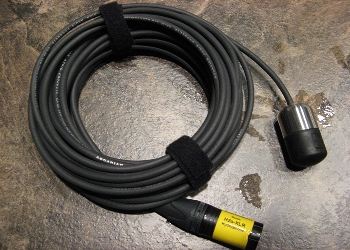 I’m taking what feels like a once-in-a-lifetime trip to the Galapagos next month (it’s actually the third trip for my brother-in-law, so who knows). While there, I’m planning to shoot a lot of professional video. And with that of course comes recording professional sound. I anticipate extraordinary proximity to sea creatures of the kind that’s very unusual, and I want to make the most of it. So I’m gearing up, and one of the things I’ll be packing to listen below the surface is an Acquarian Audio hydrophone. I did a fair bit of research before I made this purchase, and found a lot of options, most of them from companies based in the Northwest.
I’m taking what feels like a once-in-a-lifetime trip to the Galapagos next month (it’s actually the third trip for my brother-in-law, so who knows). While there, I’m planning to shoot a lot of professional video. And with that of course comes recording professional sound. I anticipate extraordinary proximity to sea creatures of the kind that’s very unusual, and I want to make the most of it. So I’m gearing up, and one of the things I’ll be packing to listen below the surface is an Acquarian Audio hydrophone. I did a fair bit of research before I made this purchase, and found a lot of options, most of them from companies based in the Northwest.
On the low end (pricewise), there’s a company in Vancouver, BC, called Cold Gold that markets a full line of hydrophones, many of them around $50. Right here in Seattle there’s a company called Cetacean Research Technology that makes hydrophones. But the fact that they neither list prices online nor offer online ordering was a deterrent for me.
I decided to go with the H2a-XLR hydrophone made by an Anacortes firm called Aquarian Audio. I ordered this one despite the fact that it’s nearly $200 (with the extra cable and shipping), not just because of the fantastic info on their website (which includes a slew of real-life recording samples), but also because in my research I found that a sound recordist whose work I respect, Miguel Isaza, uses this brand. He has a post on how to record underwater sounds with a hydrophone that helped inspire me to take one of my own on the trip.
I posted a question on the Acquarian Audio website and not only did Robb, the proprietor, respond personally – he actually called me and left a message that helped me decide on the appropriate length of cable I needed. I was thinking that 20 feet of cable would be about right for dangling off the boat, but he suggested that 30′ is the minimum to get below sounds that originate in the boat, such as generators that are often running on tour boats such as the one we’re chartering. In fact, he suggested 50′ would be best, but I’m going with the 30′ length, which is one of the standard configurations available on the Aquarian Audio website, because of space considerations (I’m already taking too much filmmaking equipment).
I’ll be posting samples as soon as I’m back from the trip. One last thing: here’s the best brief primer I could find on how to make underwater recordings of sea life (includes info on how to rig microphones – good stuff): Taking a Picture of Underwater Sounds (PDF, 66 KB)
Pingback: Aquarian hydrophone | Christianwarne
Hello, we were hoping to hear a sample of your H2A hydrophone recordings from the Galapagos. We were trying to decide between the H2A hydrophone or the Jez Riley French D-series hydrophone. I searched the blog for the recordings you were mentioning but couldn’t find any.
Hi Wil,
I ended up not using it much, but I did get one really nice recording of a rocky beach with pebbles washing in and out with the waves. I’ll see if I can find it and post that for you.